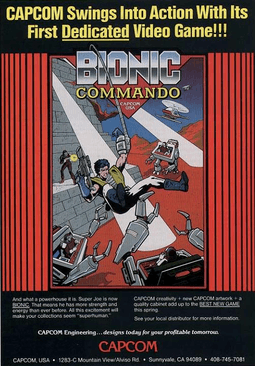Bionic Commando (arcade)
| Bionic Commando | |
|---|---|
|
Arcade flyer | |
| Developer(s) |
Capcom (Arcade) Software Creations (PC) |
| Publisher(s) |
Capcom (Arcade) Go! (PC) |
| Designer(s) | Tokuro Fujiwara |
| Composer(s) | Harumi Fujita[1] |
| Series | Bionic Commando |
| Platform(s) | Arcade, Amiga, Amstrad CPC, Atari ST, Commodore 64, DOS, ZX Spectrum |
| Release date(s) |
‹See Tfd› |
| Genre(s) | Platform |
| Mode(s) | Single-player (2-player alternating) |
Bionic Commando, released in Japan as Top Secret (Japanese: トップシークレット, Hepburn: Toppu Shīkuretto), is a 1987 action platform game released by Capcom for the arcades. It was later released for several home computers (ported by Software Creations and published by Go!). Capcom later produced a home version for the Nintendo Entertainment System, also titled Bionic Commando, that was drastically different from the original arcade game.
The game was advertised in the United States as a sequel to Commando, going as far to refer to the game's main character as Super Joe (the protagonist of Commando) in the promotional brochure,[3] who was originally an unnamed member of a "special commando unit" in the Japanese and World versions.[4][5]
The protagonist of the game is a commando equipped with a bionic arm featuring a grappling gun, allowing him to pull himself forward or swing from the ceiling. The series is notable for being one of few instances of a platform game in which the player cannot jump. To cross gaps or climb ledges, the hero must use his bionic arm. This was the first game to feature a grappling gun/hook, which later appeared in games such as Batman The Movie, Earthworm Jim and Tomb Raider.[6]
Setting
According to the original arcade version's installation manual, the story takes place ten years after an unspecified World War between two warring factions.[7] The game follows a commando who must infiltrate an enemy base and foil the enemy's plot to launch missiles. The protagonist must pass through four stages to do so:
- Level 1: Forest
- Level 2: Enemy Outpost ("The Forefront")
- Level 3: Underground Base ("Infiltration")
- Level 4: Final Base
In the Final Base, the hero must stop a missile from launching and then fight the final boss, the leader of the enemy forces, guarded by an armed bodyguard.
In some computer ports, there is an additional level between levels 3 and 4, featuring enemy helicopters.
Gameplay
The levels themselves are, like any conventional platformer, straightforward and semi-linear, with many situations in which there are enemies and other dangers lurking, while at the same time, cliffs that must be passed through. However, unlike most platformers, the player is unable to jump, instead navigating the level via the use of a mechanical arm that can pull him up ledges. The arm may also be used to collect pickups.
Prizes like points and power-ups can only be obtained from crates that come on the screen in a parachute, which can be revealed by shooting them. Unlike most of the later games, the player cannot use the arm and shoot at the same time, the arm cannot be used in the air and the only power-ups are weapon enhancements.
Home versions
| Reception | ||||||||||||||||
|---|---|---|---|---|---|---|---|---|---|---|---|---|---|---|---|---|
| ||||||||||||||||
| ||||||||||||||||
Home computer ports of the game—DOS, 8-bit computers Amstrad CPC, Commodore 64 and ZX Spectrum and 16-bit computers Amiga and Atari ST—generally received average or decent reviews, apart from the ZX Spectrum version which was greeted by some critical praise, receiving ratings of 9/10 and 92% from Your Sinclair[14] and CRASH.[15]
For Commodore 64 there are two distinct versions: a US version by Capcom, and a UK version by Software Creations. The UK Commodore 64 version seems to be the most well-received computer port, while the US version is considered poor.[16]
An emulation of the arcade version is included in Capcom Classics Collection Vol. 1 for PlayStation 2 and Xbox; and Capcom Classics Collection: Remixed for PlayStation Portable.
Record
The world record high score for Bionic Commando was set in October 2007 by Rudy Chavez of Los Angeles, California. Chavez scored 2,251,090 points.[17]
Music
The music for the Commodore 64 PAL conversion was arranged by Tim Follin, using a music playback engine programmed by Follin's brother. The original music was composed by Harumi Fujita for the YM2151 arcade-game sound chip.[1]
The game was voted Best 8-bit Soundtrack of the Year at the Golden Joystick Awards.[18]
See also
- Bionic Commando, for other games in the series.
References
- 1 2 "Junko Tamiya Interview: Creating Capcom's Incredible NES Scores". Video Game Music Online. 2014-05-19. Retrieved 2016-02-13.
- ↑ "Release information for Bionic Commando (Arcade version)".
- ↑ "The Arcade Flyer Archive - Video Game: Bionic Commando, Capcom".
- ↑ "The Arcade Flyer Archive - Video Game: Bionic Commando, Capcom".
- ↑ "The Arcade Flyer Archive - Video Game: Top Secret, Capcom".
- ↑ Playing With Power, 1UP
- ↑ Capcom. Bionic Commando. Arcade. Level/area: Instruction manual, page 1.
It has been 10 years since the devastating world war. The enemy surprised us with gigantic missiles this time.
- ↑ "Archive - Magazine viewer". World of Spectrum. Retrieved 2013-04-04.
- ↑ "Archive - Magazine viewer". World of Spectrum. Retrieved 2013-04-04.
- ↑ "Archive - Magazine viewer". World of Spectrum. Retrieved 2013-04-04.
- ↑ "Bionic Commando". Ysrnry.co.uk. Retrieved 2013-04-04.
- ↑ "Archive - Magazine viewer". World of Spectrum. Retrieved 2013-04-04.
- ↑ "Archive - Magazine viewer". World of Spectrum. Retrieved 2013-04-04.
- ↑ "YS: Bionic Commando". Ysrnry.co.uk. Retrieved 2012-01-31.
- ↑ "CRASH 53". Crashonline.org.uk. Retrieved 2012-01-31.
- ↑ "Bionic Commando (UK version)". Lemon 64. Retrieved 2012-01-31.
- ↑ "Bionic Commando High Score". TwinGalaxies.com. Retrieved 2011-03-15.
- ↑ "Archive - Magazine viewer". World of Spectrum. Retrieved 2012-01-31.
